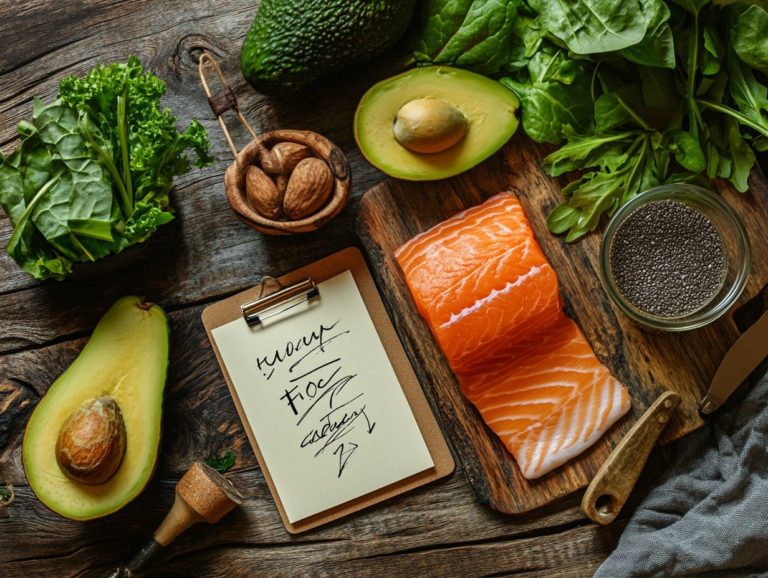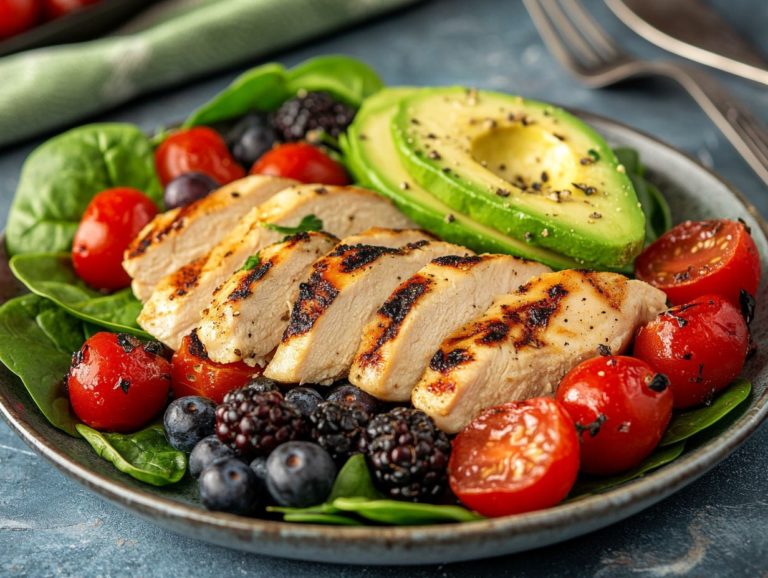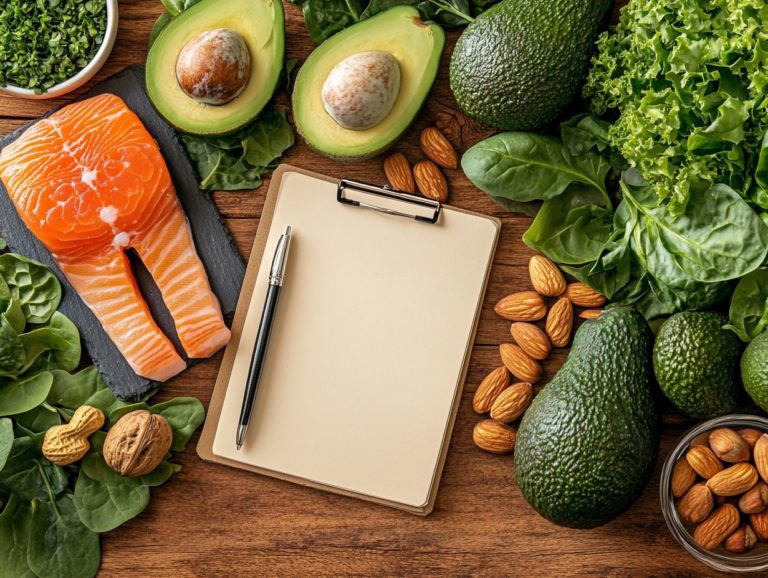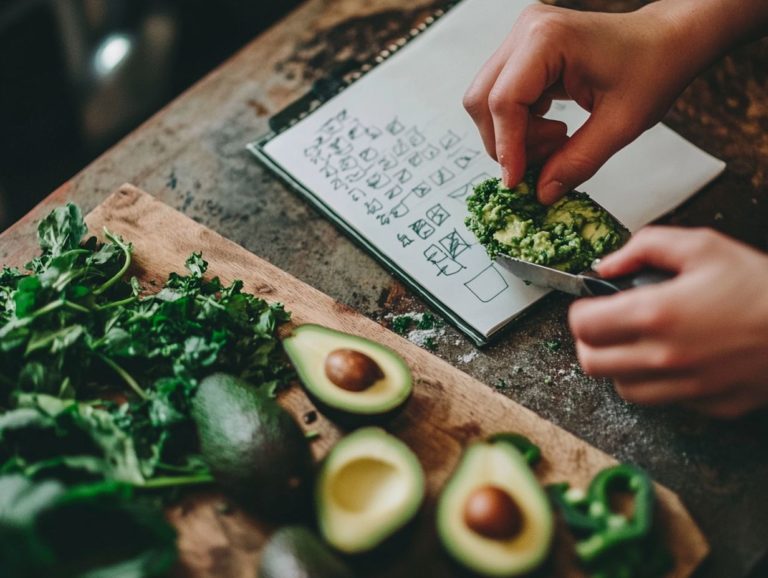Keto Diet and Meal Plans: Your Questions
The Keto Diet has become a sensation, renowned for its innovative approach to weight loss, metabolic health, and overall well-being. So, what exactly does it entail?
This guide will walk you through the essentials of the Keto Diet, including meal planning tips and keto recipes, detailing the foods you’ll love and those you’ll want to steer clear of.
You’ll discover the impressive benefits it offers, from effective weight loss to improved heart health, while also exploring the various types of keto diets at your disposal, including high-protein keto and vegetarian keto options.
You will find practical tips for crafting a successful meal plan, including food substitutions and cooking tips, along with a look at common misconceptions that might be clouding your understanding.
Whether you’re a seasoned dieter or simply curious about the Keto lifestyle, this information will equip you with everything you need to embark on your journey with confidence, including a detailed shopping list and meal prep ideas.
Contents
- Key Takeaways
- What is the Keto Diet?
- Can the Keto Diet Improve Heart Health?
- Does the Keto Diet Help with Diabetes?
- What Are the Different Types of Keto Diets?
- Ketogenic Diets Overview
- 4. High-Protein Ketogenic Diet
- How to Create a Keto Meal Plan?
- What Are Some Sample Keto Meal Plans?
- Tips and Misconceptions About the Keto Diet
- Keto Diet: Your Questions Answered
Key Takeaways

- The Keto Diet is a high-fat, moderate protein, and low-carb diet that forces the body to burn fat for energy instead of carbohydrates. It includes nourishing keto-friendly foods tailored to fit various dietary preferences.
- Get ready for a transformative journey with the Keto Diet! Not only can it help with weight loss, but it might also improve your heart health and manage diabetes.
- There are different types of Keto Diets, such as Standard, Cyclical, Targeted, and High-Protein, and it is essential to choose the one that aligns with your goals and lifestyle.
What is the Keto Diet?
The keto diet, also known as the ketogenic diet, is a high-fat, low-carbohydrate eating plan that has surged in popularity due to its impressive health benefits, particularly in enhancing the body’s ability to use energy efficiently and supporting healthy weight loss.
By significantly cutting back on carbohydrates and replacing them with dietary fat, your body enters a state of ketosis, a state where the body burns fat for energy instead of carbs. In this state, it becomes remarkably efficient at burning fat for energy instead of relying on glucose. This shift helps with appetite suppression and better blood sugar control.
This pivotal shift in energy sources can lead to a range of positive outcomes, including better blood sugar control and appetite suppression, making it an enticing option for anyone looking to manage their weight or improve their overall health. Incorporating nutrient-rich foods and healthy fats is key to maintaining this sustainable diet.
What Foods Are Allowed on the Keto Diet?
On the keto diet, you have the opportunity to indulge in a delightful array of keto-friendly foods that are rich in healthy fats and low in carbohydrates. This allows you to meet your dietary needs while keeping your net carbs in check. Think of foods like eggs, cheese, and Greek yogurt as your go-to sources of protein and dietary fat. Meanwhile, vegetables such as leafy greens and low-sugar fruits provide essential vitamins and minerals without tipping the scales on your net carb allowance. Meats like chicken, fish, and turkey are also vital for supporting your body s protein needs as you navigate this low-carb lifestyle.
Incorporating these foods into your daily meals can be both exciting and satisfying. Picture starting your day with delicious breakfast ideas like a omelet brimming with spinach and feta cheese, or savoring grilled chicken alongside saut ed zucchini and bell peppers for lunch. Healthy fats are at your fingertips, too, with avocados and olive oil being perfect for drizzling over salads or blending into your favorite dressings.
For meal prep inspiration, consider crafting a creamy cauliflower soup that brings comfort to your dinner table, or whip up cauliflower rice as a grain substitute to accompany your favorite stir-fry. No-cook plates and keto snacks can also be excellent additions to your meal planning strategies. By creatively combining these ingredients, you ensure that your meals not only align with keto guidelines but also delight your palate.
No-cook plates and keto snacks can also be excellent additions to your meal planning strategies.
What Foods Should Be Avoided on the Keto Diet?
To successfully adhere to the keto diet, it s essential for you to steer clear of foods that are high in carbohydrates. Excessive carbohydrate intake can significantly hinder your ability to achieve and maintain ketosis. This means that items like bread, pasta, sugary snacks, and starchy vegetables should be eliminated from your meal plan. This helps in managing dietary restrictions and sustaining ketosis effectively.
Understanding your dietary restrictions while implementing effective weight loss strategies is crucial. Making informed food choices will help you reach your health goals more efficiently. Consider consulting resources like the Mayo Clinic for expert advice on managing your diet.
As you navigate this dietary journey, explore delicious low-carb alternatives that can satisfy your cravings without compromising your ketosis. Consider incorporating foods such as:
- keto-friendly beverages
- zucchini noodles
- cauliflower rice
- almond flour for baking and snacks
These serve as fantastic substitutes for traditional high-carb options. When you go grocery shopping, aim to stick to the perimeter of the store, where you’ll find fresh produce, meats, and dairy. This approach helps you avoid the processed foods that tend to lurk in the aisles.
Planning your meals ahead of time can simplify cooking by ensuring that all your ingredients align with your dietary preferences. Utilize a digital shopping tool to streamline your grocery shopping. This allows for creativity and variety while keeping you firmly within the principles of the keto diet.
What Are the Benefits of the Keto Diet?
The keto diet offers exciting health benefits that go beyond just weight loss! It can enhance blood sugar control and improve insulin sensitivity, making it an appealing choice for those managing diabetes or hypertension.
Proper meal planning and cleaning out your kitchen can help in adhering to the dietary guidelines. By encouraging a state of ketosis, this diet significantly reduces hunger, making it easier for you to stick to caloric restrictions and adopt sustainable weight loss strategies.
Research shows that maintaining a ketogenic lifestyle can positively affect A1C levels, thereby promoting better metabolic health and overall well-being.
Does the Keto Diet Help with Weight Loss?
The keto diet is a powerful ally in your weight loss journey, expertly facilitating healthy weight loss through appetite suppression and enhanced fat oxidation. By significantly cutting back on carbohydrates, your body is prompted to use stored fat for energy, leading to a reduction in overall body weight.
Many individuals find themselves experiencing notable weight loss results within the first few weeks of adopting the ketogenic lifestyle, which is why it has become a favored strategy among those seeking to shed pounds. Utilize meal planning strategies to maximize these benefits.
This remarkable transformation occurs when your body enters a state of ketosis, becoming adept at utilizing fat for energy while simultaneously lowering insulin levels. This process not only curbs fat storage but also diminishes hunger hormones, reducing your cravings for food. Hence, you can better stick to your meal plan.
Inspiring testimonials often pop up, showcasing impressive outcomes like one participant who lost 20 pounds in just a month, crediting the diet for curbing cravings and revving up metabolism. People frequently share their experiences of heightened energy levels and enhanced mental clarity, further reinforcing the keto diet s reputation as an effective tool for weight loss, supported by well-structured weight loss strategies.
Can the Keto Diet Improve Heart Health?
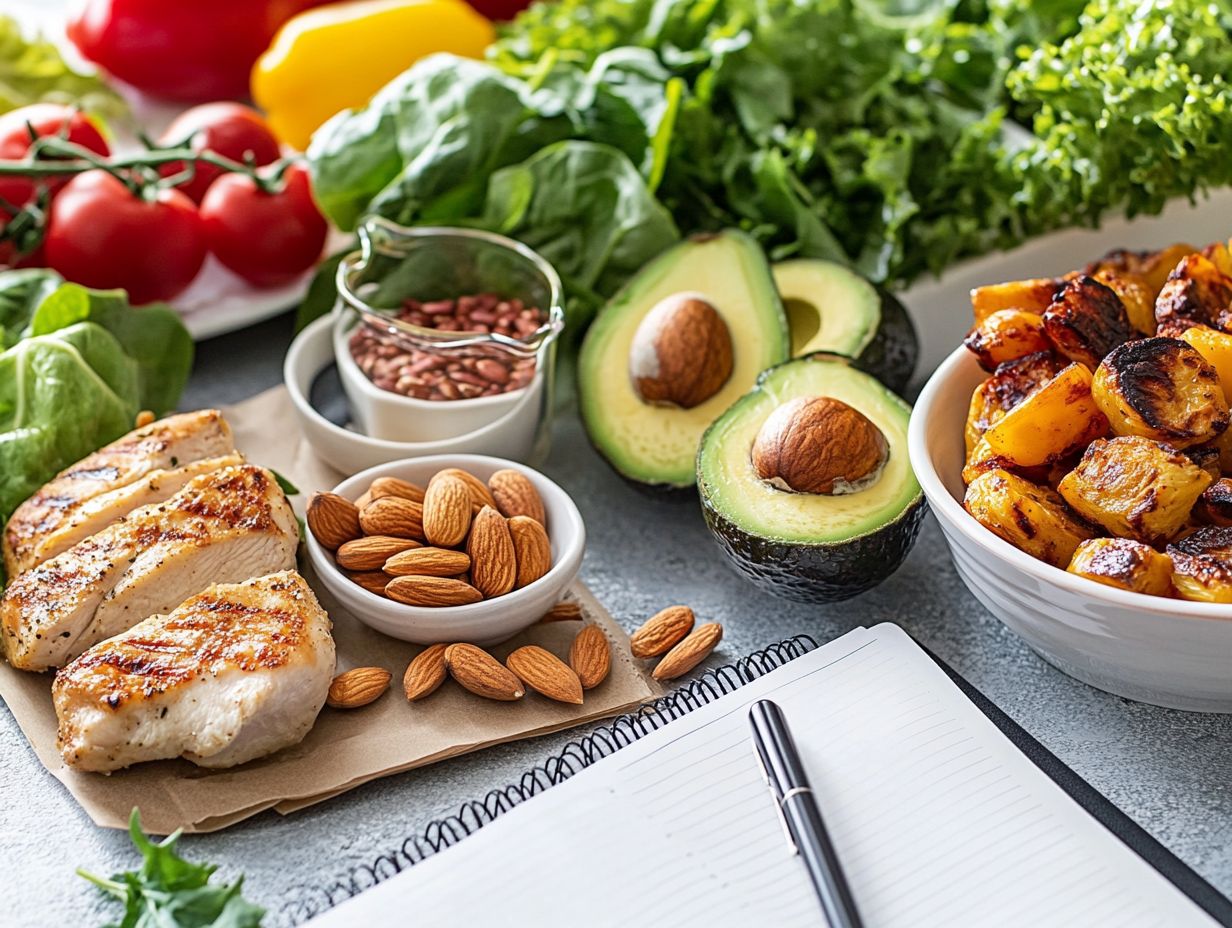
The keto diet holds great promise for enhancing your heart health by encouraging the intake of healthy fats while cutting back on carbohydrates.
This shift can lead to lower blood pressure and improved metabolic health. Consider including foods like fatty fish in your meal planning to support these benefits.
Research suggests that a well-structured ketogenic diet may positively affect crucial factors such as cholesterol numbers, triglycerides, and insulin sensitivity, making it particularly beneficial for anyone dealing with hypertension or other cardiovascular issues.
By prioritizing dietary fats from sources like olive oil, avocados, and fatty fish, you can support a lifestyle that champions heart health. Utilize a meal planning tool to track and manage these components effectively.
Numerous studies back this approach, showing that it can elevate your HDL (the “good” cholesterol) while simultaneously lowering your LDL (the “bad” cholesterol) both essential markers of cardiovascular well-being.
A meta-analysis published in the journal Nutrients highlights that even a brief stint on a ketogenic diet can lead to notable reductions in triglyceride levels and enhancements in overall lipid profiles.
Cardiovascular experts also emphasize that the anti-inflammatory benefits associated with ketosis can further contribute to lower blood pressure, creating an ideal environment for heart health and reducing the likelihood of heart-related issues.
Managing your carbohydrate intake effectively plays a key role in achieving these benefits.
Does the Keto Diet Help with Diabetes?
The keto diet can indeed be a powerful ally in managing diabetes, enhancing insulin sensitivity and helping you maintain healthy blood sugar levels essential for keeping those A1C numbers in check.
By significantly cutting back on carbohydrate intake, the ketogenic diet minimizes those pesky blood sugar spikes, leading to more stable glucose levels throughout your day.
This approach has gained attention for its potential to enable individuals with diabetes to manage their condition more effectively. Consult with healthcare providers like the Mayo Clinic when making dietary changes.
Research suggests that embracing a ketogenic lifestyle may boost your metabolic health, which, in some cases, can even reduce the need for medication.
A study published in the journal ‘Diabetes Care’ showcased substantial improvements in glycemic control among participants who adhered to a low-carb, high-fat regimen.
The increased fat consumption encourages your body to tap into fat stores for energy, which can help reduce overall body fat and enhance your insulin response.
Consider utilizing keto-friendly foods and beverages to support these goals.
Experts recommend incorporating non-starchy vegetables and adequate protein into your diet to maintain nutritional balance while adopting this sustainable approach to long-term diabetes management.
This guidance supports your transition to a dietary strategy that holds promise for managing your health by promoting healthy weight loss and metabolic health.
What Are the Different Types of Keto Diets?
You ll find that there are various types of keto diets designed to cater to different dietary needs and lifestyle preferences, including vegetarian keto options.
Among these are the Standard Ketogenic Diet (SKD), Cyclical Ketogenic Diet (CKD), Targeted Ketogenic Diet (TKD), and High-Protein Ketogenic Diet.
Each variation puts its own spin on the traditional ketogenic approach, allowing you to tailor your diet to meet specific goals whether that’s boosting performance, building muscle mass, or simply maintaining a healthy lifestyle.
Understanding your protein needs and carbohydrate intake will help you better align these diets with your dietary preferences.
By grasping the nuances of these different diets, you can confidently select the one that best aligns with your health objectives and dietary restrictions.
Ketogenic Diets Overview
1. Standard Ketogenic Diet (SKD)
The Standard Ketogenic Diet (SKD) stands out as the most popular version of the keto diet. It typically features a nutrient composition of about 70% fats, 25% protein, and just 5% carbohydrates. This classic approach is designed to induce ketosis, a state where your body burns fat for energy while minimizing carbohydrate intake. Many individuals find the SKD remarkably effective for weight loss and enhancing metabolic health.
By prioritizing high-fat foods like avocados, nuts, and olive oil, along with moderate protein sources such as poultry, fish, and dairy, you can easily transition into a low-carb lifestyle. Your food choices can also include non-starchy vegetables that are low in carbs, like leafy greens and broccoli. Incorporating low-sugar fruits can add variety while keeping net carbs in check.
The SKD is particularly attractive to newcomers, as it provides a clear structure that simplifies meal planning and helps curb hunger cravings. This makes it much easier to stick to the plan. As you embark on this journey into ketosis, you may find yourself experiencing heightened energy levels and improved mental clarity! These benefits can significantly enrich your overall experience and bring you closer to your health goals.
2. Cyclical Ketogenic Diet (CKD)
The Cyclical Ketogenic Diet (CKD) is designed for individuals who engage in high levels of physical training and require periodic carb loading to restore important glycogen stores. Follow the standard keto protocol for five days, then enjoy a two-day window of higher carbohydrate intake to prepare your body for intense workouts. This method is particularly advantageous for high-performance athletes seeking to maintain energy levels while enjoying the benefits of a ketogenic lifestyle.
By managing your nutrient intake strategically, you can experience enhanced endurance, quicker recovery, and improved overall metabolic flexibility. The CKD is especially appealing if you aim to maximize your performance while enjoying the benefits of fat adaptation, which allows your body to use fat as its primary fuel source.
You might encounter challenges transitioning into this diet, especially during the initial adjustment phase known as the keto flu, when low energy and cravings can occur. However, there are effective strategies to overcome these hurdles. Stay well-hydrated, consume electrolyte-rich foods, and carefully plan your carb refeed days to align with your training schedule. This will ensure that you fuel your body for peak performance!
3. Targeted Ketogenic Diet (TKD)
The Targeted Ketogenic Diet (TKD) allows you to enjoy a small amount of carbohydrates around your workouts, providing a quick energy source without disrupting ketosis. This strategy enables you to enjoy the benefits of the keto diet while meeting the energy demands of intense physical activities. TKD is especially appealing if you want to maintain your performance during exercise while adhering to a low-carb lifestyle.
By timing your carbohydrate intake typically about 30 to 60 minutes before physical exertion you can maximize your energy levels and enhance your workout output. This approach not only fuels your muscle performance but also aids in recovery, making it easier to return to ketosis after exercising.
Within the broader keto framework, TKD promotes a balanced consumption of nutrients that supports both fat adaptation and high-intensity activity. For those leading an active lifestyle, this balance means you can enjoy significant benefits, such as improved endurance and mental clarity, while still taking full advantage of the fat-burning perks that come with ketogenic eating.
4. High-Protein Ketogenic Diet

The High-Protein Ketogenic Diet is a refined twist on the traditional keto approach, designed to elevate your protein intake while keeping carbohydrates low. This makes it an excellent choice for those seeking to meet higher protein demands. You ll typically find a balance of fats, proteins, and carbs of around 60% fats, 35% protein, and just 5% carbohydrates. This supports both muscle maintenance and growth.
This variation benefits those who engage in resistance training or simply want to up their protein game. It also aligns well with those who have specific dietary restrictions or follow a high-protein keto lifestyle.
By placing a premium on protein, this dietary strategy not only aids in muscle repair and growth but also helps you feel satisfied for longer. This can curb your overall calorie intake. If you re an athlete, a bodybuilder, or anyone looking to shed some pounds while maintaining lean mass, this diet is a game-changer for achieving your fitness goals!
Your menu can include:
- Lean meats like chicken and turkey
- High-quality fish such as salmon and tuna
- Plant-based proteins like tofu and tempeh
Including these options in your diet ensures you are meeting your protein needs while also enjoying a variety of flavors and culinary experiences.
How to Create a Keto Meal Plan?
Creating a keto meal plan means choosing foods that meet your macronutrient goals. Aim for variety to keep your meals enjoyable and to adhere to the keto diet with ease. Make sure to incorporate nutrient-rich foods to support your overall health.
Start by creating a shopping list that highlights keto-friendly foods such as:
- High-quality meats
- Healthy fats
- Low-carb vegetables
- Suitable snacks
Embracing meal prep is crucial; it ensures you always have a convenient, compliant option available, minimizing the temptation to veer off your diet. Consider utilizing a digital shopping tool to simplify the process of finding keto-friendly foods.
What Are Some Sample Keto Meal Plans?
Sample meal plans offer inspiration for your ketogenic journey, helping you explore different meal types to suit your dietary preferences and goals.
A well-rounded meal plan might include convenient no-cook plates for those hectic days, hearty breakfast ideas like scrambled eggs paired with avocado, and satisfying keto snacks such as cheese and nuts to keep your energy levels up throughout the day. By exploring various keto recipes, you can elevate your culinary experience while staying true to your dietary goals.
Categorizing these plans into specific meal types allows you to easily tailor your daily intake to suit your personal preferences and nutritional needs.
For breakfast, consider options like banana pancakes made with almond flour or Greek yogurt parfaits layered with fresh berries to kick-start your day while keeping carbs in check.
For lunch, think of a zesty chicken salad tossed in olive oil or zucchini noodles topped with flavorful pesto. For dinner, you might enjoy a rich beef stir-fry or a salmon fillet drizzled with a tantalizing lemon butter sauce.
And let’s not forget about those delightful snacks, such as pepperoni chips or homemade guacamole paired with crunchy celery sticks, ensuring you maintain consistent energy levels without sacrificing flavor. Don’t forget to hydrate! Try refreshing herbal teas or sparkling water to keep your energy up and your taste buds happy.
Tips and Misconceptions About the Keto Diet
What Are Some Tips for Sticking to a Keto Meal Plan?
Implementing effective meal planning strategies can significantly aid in maintaining your ketogenic diet with ease.
Sticking to a keto meal plan can certainly present its challenges, but it’s essential for reaching your health goals. Implementing effective meal planning tips becomes critical for your long-term success in this endeavor.
Begin by conducting a thorough kitchen clean-out to eliminate high-carb foods that might lure you into straying from your diet. Planning your meals and snacks in advance and utilizing smart cooking strategies for simple keto recipes will bolster your commitment to the ketogenic lifestyle.
This proactive approach not only minimizes temptation but also cultivates a supportive environment, reinforcing your dedication to the diet. If you’re new to keto, creating a weekly menu featuring breakfast, lunch, dinner, and snacks will ensure you have balanced meals that meet your nutritional needs. For more information, check out the keto diet and meal replacement FAQs.
Prepare bulk meals and freeze portions for those busy days you’ll thank yourself later! When cravings strike, having a stash of keto snacks readily available can prove to be a true lifesaver. Meal planning strategies, like the Squeaky Clean Keto Challenge, can keep you on track and motivated.
Also, keep an eye on your daily carbohydrate intake. This mindfulness not only supports your adherence to the diet but also helps you sidestep common pitfalls that can derail your healthy weight loss progress.
What Are Some Common Misconceptions About the Keto Diet?
You may encounter a number of misconceptions about the keto diet that could lead to confusion if you’re considering this dietary approach. Gaining clarity on these myths will enable you to align your health goals with realistic expectations and better understand its metabolic health impact.
Many individuals mistakenly view the ketogenic diet as merely a passing fad or deem it unhealthy because of its high fat content. Some might even believe it’s only appropriate for those without dietary restrictions or specific health benefits such as blood sugar control and appetite suppression.
In truth, when executed thoughtfully, a ketogenic diet can be customized to accommodate a wide range of dietary needs, including various dietary preferences and restrictions.
Is the Keto Diet Safe for Everyone?
The keto diet often gets a thumbs-up for being safe for many, but it s not a one-size-fits-all solution, especially for those with certain health conditions or dietary restrictions. Before diving into the world of ketosis, it s essential for you to consult a healthcare professional particularly if you have diabetes or take medication for hypertension.
Significant dietary changes, including keeping track of your carbohydrate intake and dietary fat intake, can have notable effects on your health and A1C levels.
Regarding assessing the safety of the keto diet, various individual factors come into play. If you have conditions like liver disease, pancreatitis, or gallbladder issues, the ketogenic approach might complicate things, necessitating tailored strategies that suit your needs.
If you re on specific medications for blood sugar regulation or cholesterol management, you may need to tweak your meal plans. It s important for you to not only consider these medical implications but also recognize the value of personalized nutritional guidance and meal planning tips.
Seeking professional advice can provide the necessary adjustments, ensuring that the keto diet aligns perfectly with your unique health profile and lifestyle. This could include using a digital shopping tool for easy grocery shopping.
Can You Do the Keto Diet as a Vegetarian or Vegan?
You can absolutely embrace a vegetarian or vegan keto diet, but it requires thoughtful planning to meet your protein needs while keeping your carbohydrate intake low. If you re following a vegetarian keto plan, consider high-protein options like eggs, dairy, and plant-based proteins such as tofu and seitan. As a vegan keto dieter, focus on nourishing nuts, seeds, and high-fat plant foods like avocados and olives. Choose intentional foods and keto recipes to thrive on a keto lifestyle that aligns with your dietary preferences.
To effectively transition to a vegetarian or vegan keto diet, prioritize meal planning by including a diverse range of nutrients and flavors. For instance, swap traditional grains for cauliflower rice or spiralized zucchini to maintain low carb counts without sacrificing satisfaction. If you enjoy dining out, check out our guide on the keto diet and eating out to address your questions. Get creative with ingredients like chia seeds to whip up a rich pudding, or use coconut flour for baking. It’s all about enhancing texture and flavor while staying true to your keto goals. Incorporate keto snacks like nuts and seeds to keep your appetite in check.
Consider meal prep ideas such as a hearty salad drizzled with olive oil and topped with nuts and seeds, or a vibrant vegetable stir-fry featuring tofu or tempeh for that all-important protein boost. This way, you ll hit your macronutrient ratios while delighting your taste buds. Don t forget to include low-sugar fruits like berries to add sweetness without the carbs.
Is the Keto Diet Sustainable Long-Term?
The sustainability of the keto diet over the long term can vary, as following strict diet rules for extended periods may present some challenges. The diet can be restrictive, making it tricky to find food options or navigate social situations where high-carb foods are common. However, with the right shopping list and meal planning strategies, maintaining a sustainable diet becomes more manageable.
With thoughtful meal planning and an emphasis on nutrient-rich foods and healthy fats, you can successfully maintain your health goals and enjoy the benefits of a ketogenic lifestyle for the long haul.
To enhance your adherence, it’s crucial to incorporate a variety of delicious keto-friendly meals that keep your diet exciting and satisfying. If you have questions about timing, you can refer to keto diet and meal timing. Experimenting with different cooking methods can make meal prep more engaging, while discovering alternatives for popular high-carb foods can help you navigate social gatherings without feeling deprived. Try out new keto recipes and breakfast ideas to keep your daily menu fresh and enjoyable.
Building a support system, whether through friends or online communities, can provide the encouragement and resources you need when facing the hurdles of maintaining a keto diet. Embrace flexibility and make occasional adjustments to foster a healthier relationship with food and promote long-lasting sustainability. Consider joining challenges like the Mayo Clinic’s Squeaky Clean Keto Challenge for additional motivation and support.
Frequently Asked Questions
What is a Keto diet and how does it work?
A Keto diet is a low-carb, high-fat diet that focuses on reducing your carbohydrate intake and replacing it with healthy fats. The main goal of this diet is to put your body in a metabolic state called ketosis, a state where your body burns fat for energy instead of carbs. This metabolic state can also enhance insulin sensitivity and support healthy weight loss.
What are the benefits of following a Keto diet?
Aside from weight loss, a Keto diet has been shown to improve blood sugar control, increase energy levels, and reduce inflammation in the body. It may also have potential benefits for those with certain medical conditions such as epilepsy and PCOS. Following a proper meal plan can help you maximize these health benefits.
We encourage you to share your experiences with vegetarian or vegan keto diets and explore the options that work for you!
Keto Diet: Your Questions Answered
Do I have to give up all carbs on a Keto diet?
A Keto diet limits carb intake, but you don’t have to eliminate all carbs. Enjoy low-carb vegetables, berries, and some dairy products in moderation for variety.
How do I create a Keto meal plan?
Creating a Keto meal plan means choosing low-carb, high-fat foods. You can find many Keto-friendly recipes online or work with a dietitian to craft a personalized plan that suits your needs.
Can I eat out while following a Keto diet?
Absolutely! You can enjoy dining out while sticking to your Keto diet. Many restaurants offer low-carb options like salads, grilled meats, and veggies. You can make requests for substitutions, like swapping fries for a side salad.
Is a Keto diet safe for everyone?
A Keto diet isn’t suitable for everyone, especially those with certain medical conditions like diabetes or kidney disease. Always consult a healthcare professional before starting a new diet, and be aware of the potential for keto flu when transitioning to this low-carb lifestyle. But don’t let that stop you! With the right guidance, you can enjoy the benefits of the Keto lifestyle.


